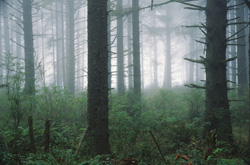How to see the wood from the trees
Forests contain more than 90% of the carbon of earth's living organisms. Forests are not only ecologically important but wood is integral to the economy. It provides materials for building things as well as energy, paper and pulp. The properties of the fibres in the wood available affects the quality of these products. Furthermore, to achieve sustainable development, the quality of wood is important because of the carbon-based secondary compounds. The biochemical components of wood such as lignin, phenolics and tannins affect the ability of the forest trees to resist the attack of pathogen and insects. This study, conducted at Georg-August-University in Goettingen in Germany addressed the relationship of wood quality with elevated CO2 levels. This was part of the EUROFACE project, which investigated the effects of global change on forest and agro forest ecosystems utilising FACE technology. FACE experiments do not alter any other aspect of the test area except CO2 concentrations and allows research on impacts of global change to be studied at ecosystem level. The scientists employed biochemical methodsand allometry (the link between shape and size) in this study. They examined the wood quality and structure of juvenile wood by microscopic technique and image analysis. To characterise the wood quality response to elevated CO2, three species of poplar were investigated. Most of the anatomical traits showed no uniform response pattern to elevated CO2. However, the combination of elevated CO2 and fertilisation with nitrogen resulted in overall losses in cell wall area, from 5 to 12% in all three clones. The findings outlined in this research point to a future where climate changes may mean a deterioration in the wood quality we see today.







